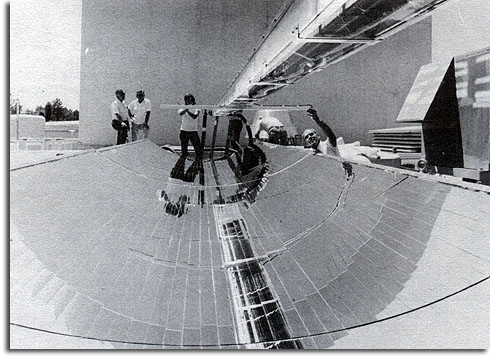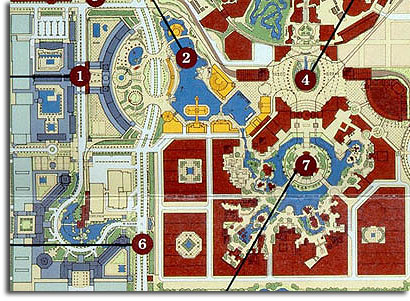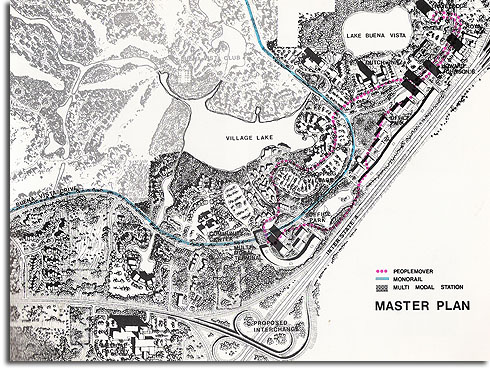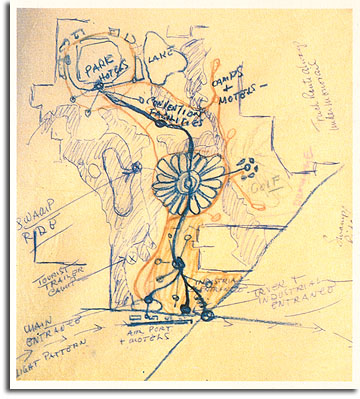Way back when in 2009, I wrote a series of articles enumerating the top ten things that I wanted to see happen to the Disney parks (and especially Walt Disney World) in that year. I managed to actually complete nine of those articles throughout 2009, but as some have been keen to remind me in the year since, I never got around to the #1 item on my list.
I actually knew what my #1 pick was when I started the series of articles, but I was rather baffled as to how to appropriately express my feelings about the issue. In a way, it ties directly into the other nine items on my list in some fashion.
Well, somehow another year has managed to breeze past and I thought that the advent of 2011 provided an appropriate window to revisit the topic and explain my #1 wish for 2009, 2011, or any other year. But first, here’s a look back at the original list.
#10 on my list was a plea for new attractions – something that would carry over into other articles as well. My focus at the time was on the need for new attractions in World Showcase, which at that time had not received a new pavilion in 21 years. Well, guess what? To continue my comparison from that original post, there are now soldiers serving in Afghanistan that are five years younger than the Maelstrom. It was embarrassing then, and it’s embarrassing now.
The last hint that I heard of anything new for World Showcase involved the Japan pavilion and that was before the economy cratered. The last widely-known proposal for an entirely new pavilion was nearly ten years ago with Spain, and something tells me we won’t be seeing that Don Quixote dark ride any time soon. World Showcase, along with most of the other “Disney Parks,” needs some real investment.
#9 called for a refocus on what originally set the Disney resort hotels apart – elaborate theming and an above-average variety of amenities. Sadly, on this front they’ve continued to pass the buck – allowing the Four Seasons to come build on property (at the new Golden Oak development) for high-end customers while Disney focuses instead on the garishly themed value resorts. Disney did decide to go ahead with the Animation suites in the abandoned Pop Century complex, but while these seem to be more elaborately themed than the existing Pop Century areas or the All-Stars, they’re still pretty enormously tacky. As for the future, it looks to be all DVC from here on out.
At #8 was a request to overhaul park merchandise. While we’ll never again see the unique park stores of yore, this is an area in which things have improved somewhat. Walt Disney World still has to catch up with Disneyland, and they both have miles to go before they touch the unique merchandise offered at Universal’s Wizarding World of Harry Potter. Thankfully the overwhelming and unprecedented success of Universal’s strategy has been so great that even the most oblivious denizens of Team Disney might pick up on it. Things are better – gone are the doldrums of “Disney Parks” sweatshirts – but the merchandising system at Walt Disney World still needs an re-think to make it truly unique once more.
#7 – Finish Animal Kingdom. Need I say more? Not a peep from over there. Still a problem.
#6 called for any of the million fixes that need to be made to Disney’s Hollywood Studios. Aside from a much, much needed upgrade of Star Tours, none of those million fixes have yet to be made. The hat remains.
#5 focused on the need for Disney to take a fresh look at all of its Tomorrowlands and figure out a clear identity for each. None have been touched since I wrote that article; Disneyland is apparently closest to receiving something new, since it’s the darling of seemingly everyone who matters. So while the wrongs of Tomorrowland ’98 might be mitigated within the foreseeable future, things are still rough in Orlando, Paris and Tokyo. We still don’t know what shape the world of tomorrow will take in Shanghai.
#4 hoped, futilely I’m sure, for “de-toonification.” While the slow creep of franchise-friendly cartoon characters into all aspects of Disney theme parks has slowed, that’s only because there has been no new expansion to speak of. There certainly hasn’t been a roll-back of atrocities like Monsters, Inc. Laugh Floor or The Enchanted Tiki Room: Under New Management.
#3 called for a return to Disney’s original ambitious transportation plans for Walt Disney World. Sadly, the only Disney transportation stories for the last two years have concerned a seemingly never-ending stream of fatalities involving Disney buses. No new monorails, no new light rail, no PeopleMovers. And since I wrote that article I’ve visited Disneyland and realized that although that resort is much, much smaller it too has bizarre transportation issues.
My runner-up, at #2, called for new love for EPCOT from The Powers That Be. Like many of the other items on this list, it hasn’t gotten worse but it hasn’t gotten better either. Journey Into Imagination continues to be an wreck, and Future World continues to be a mess of themes and approaches. At least World Showcase got a new restaurant in Italy (28 years late, but oh well).
So now that you’ve revisited my grousing of ages past, it’s time for my #1 wish for the parks. It’s very simple.
#1 – Vision
I told you it was simple. It might seem like a cop-out, but it’s clearly what is needed to help prevent all of the problems that I’ve listed previously.
Vision didn’t used to be a problem with Disney. Walt obviously had a singular vision that no one would dare question. And, arguably, modern management has a vision too. Michael Eisner seemed to have a clear agenda when he arrived, and I assume Bob Iger knows where he wants things to go. But the scope of the company’s vision has become increasingly narrow, just as it has been cluttered by the exponential diversification of the company itself.
Walt Disney Productions was fairly small company right up into the 1980s. Before Walt Disney World opened, the company’s annual revenues were far below what a single major film release brings in today. In 1971, the entire company’s revenues were $175.5 million. But, my goodness, they dreamed big. Can you imagine the modern multi-billion dollar corporation taking on a project like Walt Disney World? Like EPCOT Center? Like EPCOT city?
Take a moment and think about Walt’s concept for EPCOT. Sure, we all know about it, but think about it from a fresh perspective. Isn’t it just kind of insane when you think about it? Think: A medium-sized film and animation studio, with a single theme park, deciding to tackle the problem of urban blight and suburbanization by building a city of the future, prototype industrial park, and futuristic airport in the middle of Florida. And Walt could have done it, too. I don’t doubt that for a second.
It’s not even the scale of EPCOT that amazes but the novelty of the concept; again, this was a movie producer taking a look at the woes and inefficiencies of major cities and deciding to do something about it. It’s a long way from funny animal cartoons, but somehow, with Walt, it all seemed logical.
I’m not even asking the current Disney company to completely forego all business logic in pursuit of some lofty goal. I’m only asking that whatever developments they do pursue be approached with something at least close to the holistic process they took with earlier projects.
The prime example for me of this ideology is Walt Disney World, as originally built and up to around 1988. There’s something that has always appealed to me about the resort in those early days; pieced together like gears in a clock, all its parts seemed to work in unison and thus in harmony. This could be seen onstage, with the lack of what John Hench would call “visual contradictions,” but also backstage.
Walt Disney World cost, like many projects, more than it necessarily needed to. Despite the fact that Walt’s EPCOT never came to be, Walt Disney World did at least attempt to integrate some cutting edge prototype systems in its design. The AVAC trash disposal system is well known, and for a brief time a prototype pyrolysis plant sought to turn all that collected trash into power. Two jet engines burning natural gas provided power to the resort; waste heat from the engines went to provide hot water as well as chilled water for air conditioning. Prototype systems were used to filter sewage and waste; some effluent eventually went to fertilize the backstage tree farm, and no wastewater was discharged into local rivers or streams.
 This prototype solar collector was installed on the roof of the Walt Disney World Central Energy Plant in 1976. Through solar and other methods, Disney had hoped to make the entire resort completely energy self-sufficient.
This prototype solar collector was installed on the roof of the Walt Disney World Central Energy Plant in 1976. Through solar and other methods, Disney had hoped to make the entire resort completely energy self-sufficient.Moreover, the entire resort was designed to minimize the need for automobiles. The smaller, more organized layout of the resort made it easy to travel between any two parts of property quickly. Compare that to today, when it might take hours to get from one resort to another, and most vacation planners advise just bringing your own car to get around. The roads of the resort, originally designed to require a minimum of stoplights, now features stretches of gridlock just like any other suburban development. This is antithetical to the entire point of most Disney-planned developments in the 1960s and 70s.

Of course, Walt Disney World’s problems have been caused by piecemeal development. Disneyland’s issues come from half-measures in the master planning process. Look at this diagram of the planned WESTCOT development from the 1990s. To me, it holds together much better than the slapdash Disneyland Hotel/Paradise Pier Hotel/California Adventure plan that replaced it. The problem with passing the buck in the early stages of planning has never been more clear than with DCA; the company is now having to spend billions to rehabilitate the existing theme park, but if they’d done things right the first time they’d have a far superior product with a lower price tag. It’s expensive to right wrongs once they’ve gone from blueprints to actual steel and concrete.
In a way these are all mistakes of past management, but we should keep them in mind because they’re instructive of what should be avoided in the future. They’re also relevant because they’re mistakes we’re still paying for. For example, for the last couple of years Disney has been casting about for a redevelopment concept to replace Pleasure Island at the Disney Village. Pleasure Island and the West Side had both become a complete mish-mash of unrelated noise so now Pleasure Island is being replaced by something called “Hyperion Wharf”, which will contain a bunch of shops and restaurants with a vague warehouse district theme.
Compare these problems with the original plans for these areas from the 1970s and 80s. The first concept was to extend the Village around the lake, with similar architecture and atmosphere, and the whole area would have been linked by PeopleMover. A monorail route would have connected the Village to the rest of the resort. A later plan called for the area around the Empress Lilly, which would eventually be used for Pleasure Island, to become a mixed-use resort and shopping district themed to New Orleans. This highly-themed area would have brought a touch of New Orleans Square to Orlando and would have tied in nicely with the Empress Lilly riverboat. It would have been classy, it would have been atmospheric, and it wouldn’t have required demolition and re-construction a few decades on.
 A more sustainable and guest-friendly Lake Buena Vista Village, with PeopleMover and Monorail, was planned in 1976
A more sustainable and guest-friendly Lake Buena Vista Village, with PeopleMover and Monorail, was planned in 1976It’s not that Disney doesn’t do any planning. Obviously, any huge corporation has a number of long-term plans for its growth. At Walt Disney World, the Reedy Creek Improvement District has its own plans for the property as well. But the problem comes when all these divisions and their magical spreadsheets don’t seem to be communicating with each other, and things begin to resemble the proverbial chickens with their heads off. Everything seems to be planned and executed on a micro level, with no one bothering to take a look at the macro view.
That’s what I want. I want someone at the top looking at the big picture and really thinking about what the company is doing and why. That goes into every other point I’ve made on this list. Why are there cartoon monsters in Tomorrowland? Why is transportation at Walt Disney World such a mess? Why is Walt Disney Studios Paris such a disaster? Why has it been 15 years since Disneyland Paris received a major new attraction; why is it 23 years since there has been a World Showcase pavilion? Why did Eisner build the Dolphin and Swan so that they destroyed the view of World Showcase, and can anything ever be done about that? Why is it so hard to find themed merchandise to buy in the parks? Does “The Seas with Nemo and Friends” adequately serve the purpose of an EPCOT attraction? Do “Balzac” kiosks?
There are a million questions like this, and it’s no wonder that corporate types roll their eyes at fans and think we’re nit-picking. We are nit-picking. We’re nit-picking because – well, because somebody has to. We’re nit-picking because things have changed, and there’s something so be said for the ways that Disney used to do things.
Here’s the deal – I have no doubt that the Imagineers working today put just as much into their work as the old-timers did. Building these attractions isn’t easy and even a simple attraction involves a lot of sweat for the people involved. But everything that gets done today seems to happen in a vacuum; sure, the Imagineers might be plugging away working really hard on Laugh Floor, but what happens to all that effort when the attraction they’ve created gets plopped into Tomorrowland and ruins the theme of the area?
This is the problem. In Walt’s day the Imagineers worked on their own little projects, potentially unaware of the big picture. Walt knew the big picture. If he asked you to work on some attraction, he knew where it was going to go. This carried over by his lieutenants when he passed away. If a young designer was assigned to a project, you could trust that someone above knew how that attraction would fit into the greater whole of the park. These days, with five resorts spanning the globe and eleven theme parks, and with Imagineering working more and more on a subcontractor basis, it seems like no one has a clear vision of what any of the parks are supposed to be. How does Toy Story Mania fit into the Studios park? Eh, who cares! Just plug it in there and we’ll do some theming around it. But does anyone ever step back and say, “Why?” And now that an expensive attraction has been installed, it will make it that much more difficult to make the major physical layout changes that are needed in that park in the future.
It’s all about vision. It’s about someone being able to step back and say, “What is Tomorrowland? What does it represent and what type of attractions should it have?” It’s about looking at all the resort hotels and thinking, “Do we offer a wide-enough variety of themes and unique experiences, or are we just going through the motions?” It’s about making each attraction, each store, each restaurant unique, and not trying to achieve some absurd efficiency of scale and turn each park and hotel into a Wal-Mart. The “Disney Parks” concept is only worthwhile when it’s used to insure that each resort is brought up to the same high level of service. It fails when it’s used to make each resort just like the rest.
So, Disney executives, step back and think about what you’re doing and why. The Disney company wasn’t created to crank out widgets, so it shouldn’t be operated like some generic widget-cranking company. If you’re living for the quarterly report, you’re doing it wrong.
There’s a phrase that gets kicked around a lot in political circles called “American Exceptionalism.” This is the notion that America is, by default, basically way more super-awesome than any other country, just because it’s America. There are many of us of the Commie Pinko Liberal persuasion that think that this is not exactly true if the government ceases to act in accord with the principles that made it great in the first place. Basically, if you’re going to talk the talk you are still required to walk the walk. You can’t coast on a name forever, and this applies directly to Disney as well. Walt and Roy Disney created a company that was truly exceptional, so it’s no wonder that generations of us, the devout, are believers in “Disney Exceptionalism.” But again there’s only so far that a company can veer from the path that made it great before it, objectively, ceases to be truly exceptional.
The marketing folks can flog “Memories of Dreams and Magic and Wonder” all they want, and it’ll work for a good long time, but eventually that patina of magic will wear off and Disney will be seen as just another company. Especially when so many other up-and-comers are aiming to knock them off their perch. Universal, with its Wizarding World of Harry Potter, has created something of such detail and quality that it bests anything Disney has produced stateside in at least 15 years. Now that they’ve scored a hit, are they going to let up?
Of course it’s not like the empire is about to fall, and it’s not like all the elements aren’t in place for the Disney parks to flourish creatively. After all, they’re still by far the most popular theme parks in the world, and everyone who’s anyone in the themed entertainment industry would probably jump at the chance to help tackle projects that would equal those of WED’s golden era in the 1960s and 70s. It will never happen, though, as long as management is content to run the company like it’s just another widget-producing corporation.
It’s possible to do great things without profligate spending. Walt and Roy did it all the time. It’s not like the money flowed like wine in Walt’s time, although he did spend what needed to be spent to do a project right. Money is not what I’m talking about here. Disney could have spent $500 million on Laugh Floor, or Stitch’s Great Escape, or the Flying Carpets in Adventureland, but that wouldn’t make those attractions make sense in their context. Disney is spending roughly that much on Carsland at California Adventure, yet the fact that Radiator Springs Racers will be, most likely, an expensive and impressive attraction doesn’t change the fact that it makes no sense being placed in that theme park.
Money’s not the issue, talent’s not the issue. Vision is the issue.
David Brinkley, 1971, speaking about Walt Disney World:
“It is the most imaginative and effective piece of urban planning in America. And that is totally aside from the Mickey Mouse amusement park area itself. It is outside the park, on Disney’s own land, which is about twice the size of Manhattan. On this they have built roads, transportation systems, lakes, golf courses, campgrounds, riding stables, stores, hotels. And they all fit together in a setting of land, air and water better than any other urban environment in America.”
Now that’s vision.











And this is why I am such a huge fan of your website. Great article.
Thanks, Sam. That means a lot!
Wow. You’ve completely captured every single regret and hope I have for the Walt Disney Company! My husband and I chew over all of these issues constantly (Epcot’s moribund Future World especially) and our favorite pastime is dreaming up ways to fix them. You’ve hit the nail on the head—it’s all about vision. Now what’s it gonna take for executive management to get some?
I agree. It’s unfortunate that the vision which used to be “quality will out,” has now become “return as much on as little investment as possible.” I have felt for some time now, that younger fans only familiar with the company as it exists today, will never have the somewhat-fanatical devotion to it that older ones do–for the simple reason that there is relatively little to inspire it.
Clearly in a lot of instances, managers took Walt’s rebuke “it’s cheaper not to do it at all,” and have happily considered it a justification to…well…do nothing at all.
Very well said. You’re speaking mostly on WDW so I can’t really comment on specifics. But you’re right, the big heads of the company needs to take a look at what they’re really doing. Theming is a big part of why I loved Disneyland as a kid and still do as an adult. But the more and more they change things into thing that don’t make sense, the more and more I start to wonder how much of what I love about Disney is left. If only people on the inside would give this a ponder, something might happen for the better.
But about Radiator Springs, isn’t it supposed to be set on Route 66? So I’d say it at least has some say.
But then again, what about Ariel’s Undersea Adventure? How does a mermaid in the ocean have any connection to California?
How about Goofy’s Flight School? Not very California themed as far as I know.
Or I could just be spewing nonsense. Either way, great article.
Thanks all for the comments!
C: That’s the big question, isn’t it? What will it take… I do think we’re better off now than we were several years back, but there are miles to go before we sleep. Of course if Big Bob Iger is reading, I’ll point out that I’m completely available and willing to relocate immediately if appointed. I know what you mean about dreaming of ways to fix things – it might seem perverse, but I’ve realized that a lot of the time I spend in the parks is spent looking around and daydreaming about how I would tweak things. Last night I was having a hard time falling asleep, and realized it was because I was lying in bed brainstorming ways to effectively restructure the Studios park. I am a huge nerd.
Jeanine: You are SO right. I’ve thought many times that the reason they can only mine the “remember the magic” concept for so long is because kids coming up today will not necessarily form the same bond that we did. And kudos for the “cheaper not to do it at all” quote – I read that story over the holiday, meant to include it in my story, and forgot! This is why my readers are 100% cooler than any other blog readers anywhere.
craziemutant: You are not spewing nonsense! You speak the truth. I’m WDW-centric just because I’m an east-coaster, but obviously all my concerns apply in some way to the other resorts. In some ways Disneyland has been buffered since Pressler left because so many people at WDI and Burbank adore it so. Obviously it’s Lasseter’s favorite, so while Disneyland has received a lot of love since the Ouimet administration began the restoration process down in Orlando things aren’t as rosy. Of course Disneyland still has the Tomorrowland “issue” to deal with, but I guarantee it’ll get some love pretty soon. And then there’s DCA… you’re right there, too. Will the Mermaid ride be great? Sure. Does it have anything to do with San Francisco? Well, no. At least the Goofy coaster is purported to be just a temporary fix. Once Mermaid is there, it’s there forever.
Thanks again to everyone. You guys are the best.
Perfectly stated. I was one of the people who wondered whatever happened to that #1 New Years post, and I’m glad to see the answer was well worth the wait.
Amen brother, you hit the nail on the head.
Disney is too focused on putting band aids on things they think need fixing rather then looking at the bigger picture, and devoting it self to its own core philosophies.
An excellent essay. Did you send it to the Disney execs? I say we get rid of “Journey into Abomination” first.
You really hit the nail on the head here, as always. We often complain that the company is too cheap to spend money on X or Y, but it’s the lack of underlying vision that’s the real problem.
Fantastic article! It truly does come down to vision.
…And UGH… those Balzac kiosks. If you really want to cry, check out their website…
From one Commie Pinko Liberal to another, all I can say is: Bravo!
Consider that nail head sufficiently hit.
Very well said. The only thing I disagree with is actually in the Brinkley quote. I would hardly consider WDW a “urban environment” in 1971 or even today.
Where is the “love it” button on this post?
Incredibly well said, sir.
I especially agree with the point of Universal. They scored a major win with Harry Potter, and now that they see how successful it is, they are definitely going to try to top that for whatever project comes next for them. They have definitely made some mistakes with it in some areas, but I’m sure they will take that knowledge and apply it to make the next “big thing” even better.
Granted, I don’t think any other entertainment or theme park company will even come remotely close to knocking Disney out of the top spot, because they are pretty much THE go to for theme park stuff, but they have some serious competition coming up behind them.
One of the issues that often gets in the way of comprehensive strategic planning is the fear of changing tastes. We live in an age where interests and spending trends change more rapidly then ever. You’ve covered it well here in the internet webs, but think about the big “woosh” Disney felt when the “Princess” carpet was pulled out from under them due to a generation that’s growing up incredibly fast. Disney goes nutty on Feature Animation after Princess and the Frog, and some would say now feel “stuck” with attraction expansion plans that are all-about-princess.
Their history in the past 25-ish years seems to be that they sit back and be reactionary to trends so as to not develop projects that will quickly be outdated. It’s as if they are comfortable to take many baby steps, but don’t want to leap for fear that public interest will move on and make their expensive capital projects obsolete. Trouble is, they’ve got it backwards, and chasing trends is the quickest path to being obsolete.
All of this makes your call for a stronger vision even more resonant. If the playing field is such that people will change their opinions and likes quickly, all the more reason to develop universal concepts that focus on quality, consistency and flexibilty so the company can grown on a solid foundation for years to come. For once, let’s see them tackle a project that nobody else has….the idea of a car-free and energy independent WDW Resort would be an excellent start, or the de-toonification of certain park areas that is often suggested. These conceptual projects would capture the attention of guests for far longer then another concrete hotel box with large cutout icons that the kids can “relate” to.
Excellent article, and thanks for speaking truth.
I just wanted to say “hi” to all the new readers, and thank everyone who linked to this story. So, thanks!
Just beginning to follow the website. Fantastic insight on the “post Walt” development of Disney. Thanks for finishing up the list. I hope they’re listening to the harsh reality. Keep up the good work!
Wonderful stuff.
I think all your comments are right on the money, but the relationships between vision, sprawl, and the transportation system really hit home for me.
Keep up the good work.
Thanks!
[…] have with the management of Parks & Resorts was summed up very well by Michael Crawford in this article on Progress City USA. There is no concern (and seems to be no understanding) of the long term ramifications of the […]